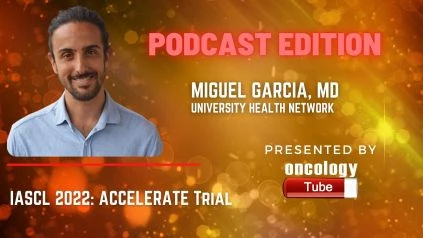Miguel Garcia, MD, Clinical Research Fellow, Division of Medical Oncology & Hematology at University Health Network. In this video, he speaks about the IASLC 2022 Abstract – Accelerating Lung Cancer Diagnosis and Molecular Profiling through Liquid Biopsy.
Â
Origins:
Â
In advanced non-small cell lung cancer, molecular profiling of tumor tissue is the gold standard for therapeutic decision-making. However, due to a lack of biopsy samples, results are frequently delayed or unavailable. By finding circulating tumor DNA (ctDNA) in plasma, liquid biopsies can help with genotyping. As part of the pre-diagnostic work-up for lung cancer, we tested the use of liquid biopsy for molecular genotyping.
Â
Methodologies:
Â
We enrolled individuals referred to our lung cancer rapid diagnostic program with a 15-pack-year smoking history and radiologic evidence of stage IV lung cancer (NCT04863924). Patients were tested for SNVs and indels in 38 cancer-related genes using a DNA-based mutation panel (Canexia Follow It®). Tissue profiling was carried out according to conventional procedure, including a full NGS (Oncomine Genome Sequencing) analysis.
Â
Comprehensive Assay v3) is a new version of the Comprehensive Assay. Plasma and tissue tests were compared in terms of identifying actionable targets, result turnaround time (TAT), and time to therapy initiation.
Â
Outcomes:
Â
Twenty individuals were included from January to June 2021; three had non-lung cancer diagnosis and 12 had lung adenocarcinoma. Seven EGFR (6) and ERBB2 mutations were found in plasma or tissue (4/7 concordant, 1 plasma only, 2 tissue alone) (1). Immunohistochemistry was used to identify fusions in three cases (2 ALK, 1 RET). Plasma sampling took an average of 2 days, while tissue biopsy took an average of 9 days. Plasma had a faster median TAT for results (17 vs. 22 days). If an actionable alteration in plasma was found, the median duration from referral to treatment beginning was 31 days (range 16-41) versus 35 days if none was found (range 20-58).
Â
Conclude:
Â
While liquid biopsy may speed up profiling results and treatment initiation in advanced NSCLC patients, more comprehensive NGS assays with faster TAT are required. A 150-person expansion trial using a complete DNA-based test with quicker TAT is now underway (SNV, indels, fusions, CNV; InVisionFirst, Inivata).

